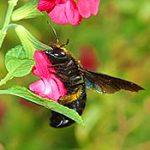Carpenter bees are large, hairy bees distributed worldwide. Their name comes from the fact that nearly all species build their nests in burrows in dead wood, bamboo, or structural timbers. In several species, the females live alongside their own daughters or sisters, creating a sort of social group. They use wood bits to form partitions between the cells in the nest. A few species bore holes in wood dwellings. Since the tunnels are near the surface, structural damage is generally minor or nonexistent.
They are often mistaken for a bumblebee species, as they can be similar in size and coloration, though most carpenter bees have a shiny abdomen, while in bumblebees the abdomen is completely clothed with dense hair. Males of some species have a white or yellow face, where the females do not; males also often have much larger eyes than the females, which relates to their mating behavior. Male bees are often seen hovering near nests, and will approach nearby animals. However, males are harmless since they do not have a stinger. Female carpenter bees are capable of stinging, but they are docile and rarely sting unless caught in the hand or otherwise directly provoked.
Carpenter bees are traditionally considered solitary bees, though some species have simple social nests in which mothers and daughters may cohabit. However, even solitary species tend to be gregarious, and often several will nest near each other. It has been occasionally reported that when females cohabit, there may be a division of labor between them, where one female may spend most of her time as a guard within the nest, motionless and near the entrance, while another female spends most of her time foraging for provisions.
Carpenter bees make nests by tunneling into wood, vibrating their bodies as they rasp their mandibles against the wood, each nest having a single entrance which may have many adjacent tunnels. The entrance is often a perfectly circular hole measuring about 16 millimetres (0.63 in) on the underside of a beam or tree limb. Carpenter bees do not eat wood. They discard the bits of wood, or re-use particles to build partitions between cells. The tunnel functions as a nursery for brood and storage for the pollen/nectar upon which the brood subsists.

